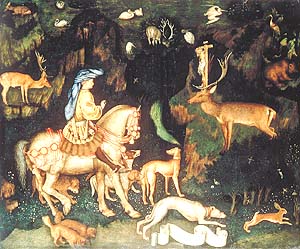Antonio di Puccio, otherwise known as Pisanello, after his native town of
“You equal nature’s works, whether you are depicting birds or beasts, perilous straits and calm seas” the humanist poet Guarino wrote, in an encomium of Pisanello written around the middle of the fifteenth century. “When you paint a nocturnal scene you make the night-birds flit about and not one of the birds of the day is to be seen; you pick out the stars, the moon’s sphere, the sunless darkness. If you paint a winter scene everything bristles with frost and the leafless trees grate in the wind. If you set the action in spring, varied flowers smile in the green meadows, the old brilliance returns to the trees, and the hills bloom; here the air quivers with the song of the birds…”
Pisanello was, as Guarino’s words indicate, admired above all for his skill and accuracy in depicting the natural world, a talent most thrillingly displayed in his sketches of the flora and fauna of fifteenth-century


